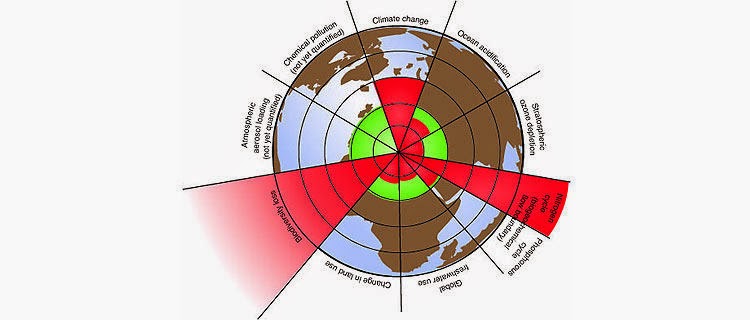Planetary boundaries is the central concept in an Earth system framework proposed by Johan Rockström from the Stockholm Resilience Centre and Will Steffen from the Australian National University. In 2009, the group proposed a framework of “planetary boundaries” designed to define a “safe operating space for humanity". This theory is based on scientific research that indicates that since the Industrial Revolution, human actions have gradually become the main driver of global environmental change.The researchers assess that once human activity has passed certain threshold level, defined as “planetary boundaries”, there is a risk of “irreversible and abrupt environmental change”.The scientists identified nine Earth system processes which have boundaries that, to the extent that they are not crossed, mark the safe zone for the planet. However, because of human activities some of these dangerous boundaries have already been crossed, while others are in imminent danger of being crossed.
The researchers identified nine "planetary systems" essential for human survival, and attempted to quantify just how far seven of these systems have been pushed already. They estimated how much further we can go before our own survival is threatened; beyond these boundaries there is a risk of "irreversible and abrupt environmental change" which could make Earth less habitable. Estimates indicate that three of these boundaries (climate change, biodiversity loss, and the biogeochemical flow boundary) appears to have been crossed.
Figure: Plot of the planetary boundaries according to the Nature paper by Rockström et al.
The 2009 study identified nine planetary boundaries and, drawing on current scientific understanding, the researchers proposed quantifications for seven of them. These seven are
- Climate change (CO2 concentration in the atmosphere < 350 ppm and/or a maximum change of +1 W/m2 in radiative forcing)
- Ocean acidification (mean surface seawater saturation state with respect to aragonite ≥ 80% of pre-industrial levels)
- Stratospheric ozone (less than 5% reduction in total atmospheric O3 from a pre-industrial level of 290 Dobson Units)
- Biogeochemical nitrogen (N) cycle (limit industrial and agricultural fixation of N2 to 35 Tg N/yr) and phosphorus (P) cycle (annual P inflow to oceans not to exceed 10 times the natural background weathering of P)
- Global freshwater use (< 4000 km3/yr of consumptive use of runoff resources)
- Land system change (< 15% of the ice-free land surface under cropland)
- Rate at which biological diversity is lost (annual rate of < 10 extinctions per million species).
The two additional planetary boundaries for which the group had not yet been able to determine a boundary level are chemical pollution and atmospheric aerosol loading.

No comments:
Post a Comment